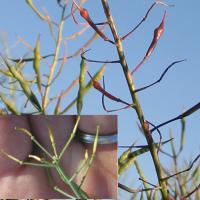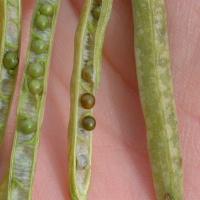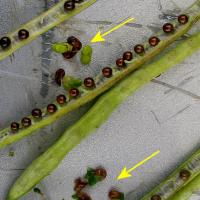Diagnosing frost damage in canola
Canola is most susceptible to frost damage from flowering to the clear watery stage (approximately 60% moisture). Plants frequently recover from frost at early flowering by producing more flowers. The most economically damaging frosts on canola are late, severe events that kills the developing seed when flowering is finished and it is too late in the season to produce more pods.
What to look for
- Low lying areas, light-coloured soil types and dry soil and areas with more retained stubble are likely to be more damaged.
Paddock
- Frost damaged plants lose flowers, abort young pods, have twisted inflorescence or have blistered pods with damaged seed.
- Canola can develop more flowers and set pods if there is sufficient time and soil moisture in the season.
- Flower abortion (particularly open flower), while buds and young pods may be unaffected.
- More severe frost causes developing buds to turn yellow, die and fall off, leaving gaps in the flowering spike between more developed pods and new flowers that form afterwards. There is often a twisted flower stem in this section.
- Severe frosts can damage developing seed, which turns into a mushy green brown mass that dries to a small black or brown speck. The pod surface can blister, turn yellow green or develop a paler blistered surface. Partial seed death leads to unevenly filled watery ripe pods.
- A late frost event during early seed fill causes significant losses with shrivelled seed that may retain its green colour and reduce oil quality.
Plant
What else could it be
| Condition | Similarities | Differences |
|---|---|---|
| Diagnosing heat stress in canola | Flower and pod abortion | Contrasting weather events |
| Diagnosing spring drought in canola | Flower and pod abortion | Contrasting weather events |
Where does it occur?
- Frost damage occurs when night air temperature falls below -2°C.
- Canola is less susceptible to frost damage than cereals as its indeterminate flowering habit allows it to keep flowering and compensate.
- Frosts occurring at the end of flowering and peak of early seed set/fill can be severely damaging.
Management strategies
- Paddock selection is critical for canola. Avoid sowing canola on high frost risk paddocks as frost damage is irreversible.
- Risk may be reduced by:
- Later sowing or choosing varieties with contrasting maturities to spread flowering time of crops.
- Sowing more tolerant crops such as oats in frost prone paddocks.
How can it be monitored?
- Inspect canola crops between grain fill and prior to swathing timing. If night air temperature (recorded 1.2m above ground) falls below -2°C.
- Check low lying, light coloured soil types and known frost prone areas first, then check other areas.
- To identify frost damage open up pods and check for mushy or shriveled grain, often these pods will have a scarred or blistered surface when inspected closely.
See also
Where to go for expert help
Page last updated: Monday, 27 November 2017 - 12:39pm







